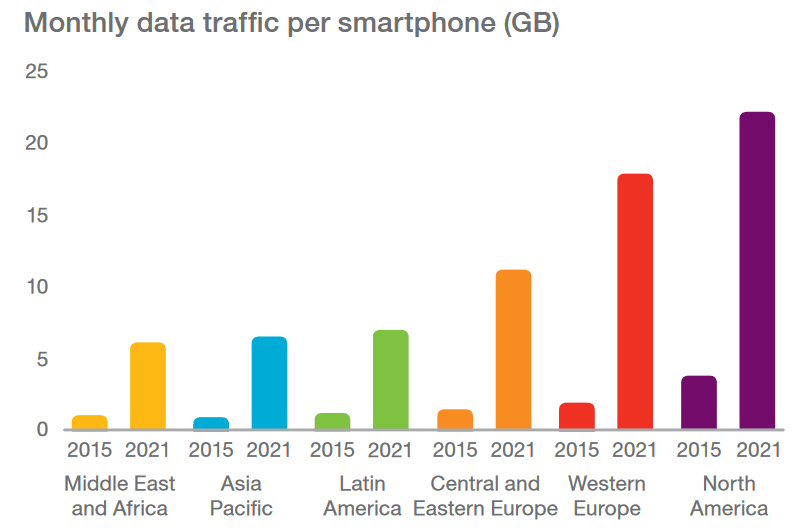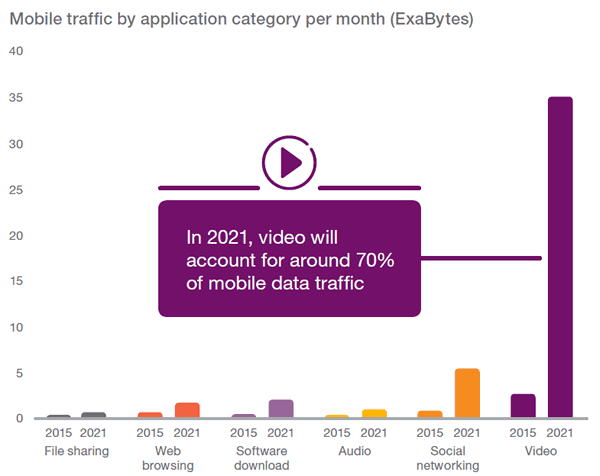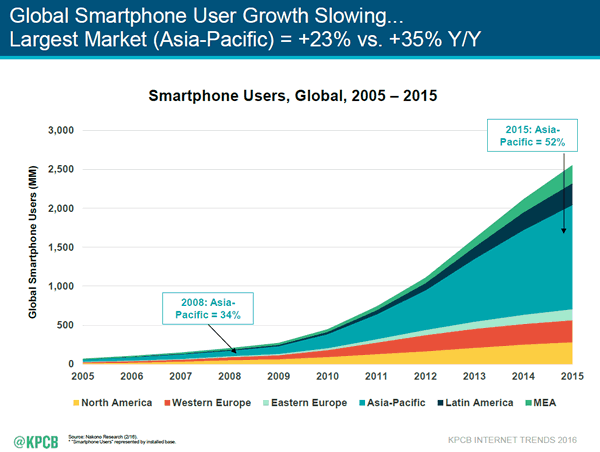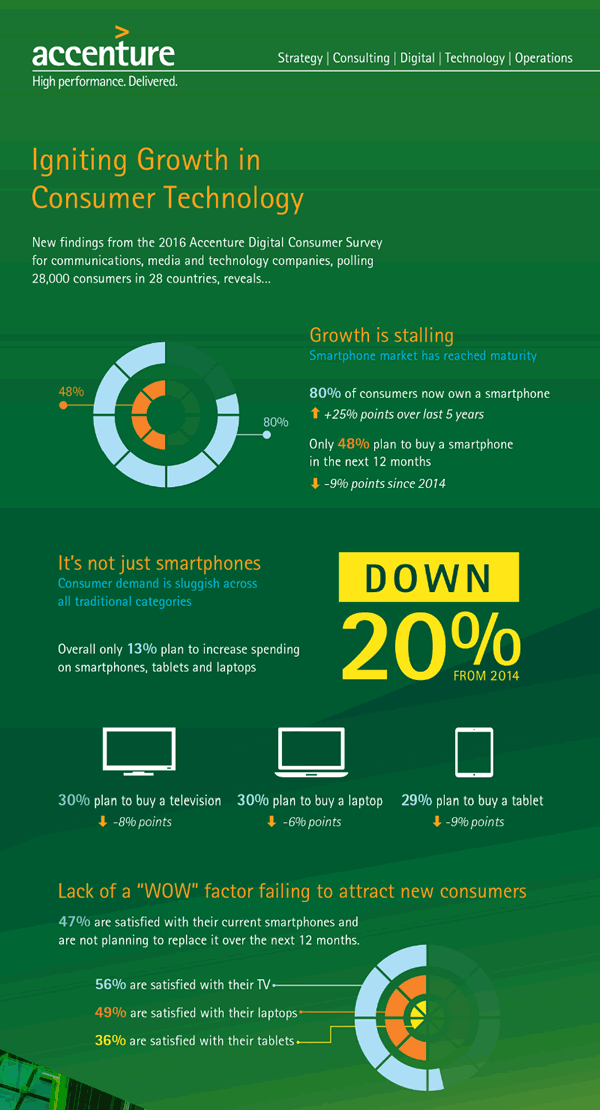If you think there is a lot of mobile data generated by smartphones, hold on for much more as our big data sphere continues to grow with an increasingly mobile consumer.
According to the Ericsson Mobility Report 2016, between 2015 and 2021 there will be a 12X growth in smartphone data traffic alone, with mobile data from smartphones accounting for around 90 percent (!) of mobile data traffic by the end of 2021.
Based upon traffic measurements in 2015, Ericsson found that the main application category is still video. On smartphones (and tablets) the share of video traffic increased as did the share of social networking. Interesting for information management professionals: file sharing happens far more via mobile PCs than using tablets and smartphones.

The explosion of mobile data traffic to come in one word: video
So, what about the future? Unless some other killer application category joins the smartphone usage ranks between now and 2021 or one of the other types of activities suddenly boost, the key reason for the huge growth of mobile data traffic is video.
Even if social networking data will grow significantly too, mobile data traffic increase from video is simply huge. By 2021, it is expected to account for around 70 percent of mobile data traffic according to Ericsson (including traffic from video, embedded in web pages and social). Moreover, the company expects that video will be a significant part of at least one other category: file sharing traffic.

Worldwide smartphone sales growth declines: context and data
The anticipated growth of mobile data traffic from smartphones is enormous. However, the growth of smartphone sales is expected to decline for the next years.
Knowing the double digit growth numbers of previous years this is not that much of a surprise. On June 1st 2016 IDC updated a previous forecast on worldwide smartphone growth, saying it expects worldwide smartphone shipments to grow 3.1 percent in 2016 (down from 5.7 percent in its March 2016 forecast).
In 2014 and 2015 the market still showed double-digit growth with respectively 27.8% and 10.5%. In total, IDC now expects 1.48 billion smartphone shipments in 2016 and a growth to 1.84 billion in 2020.
Aside from the traditional differences across various regions and countries, there are several reasons for the declining growth of the smartphone market.
In a report, ‘Igniting Growth in Consumer Technology’, which Accenture Consulting released earlier this year at the occasion of the annual CES consumer electronics show, the company said it expected stalling growth for consumer electronics across all traditional categories. And these include smartphones and tablets.
As the smartphone market hits maturity, to quote Accenture from the announcement, and as newer forms of consumer electronics (yes, indeed, you can mainly think about the Internet of Things) are not ready to compensate declines in the mentioned traditional categories, Accenture urged consumer electronics firms to step up their pace to bridge this period of slower growth in, among others, mobile devices. The reasons why IoT devices and services aren’t booming in consumer markets yet are known: price and security are two important ones but not the only as the infographic on Accenture’s site (PDF opens) shows (extract at bottom of this post).
Sami Luukkonen, Accenture: “The slowdown in the consumer technology market is irrefutable, serious and global. The market is not about the glitzy gadgets anymore – rather, it’s about providing secure, innovative and practical digital services and more open collaboration. As device demand tapers off, the industry needs to make a sharp turn toward providing innovative, value-added services that consumers are able to use with confidence”.
As you can see in that same infographic, 80 percent of consumers own a smartphone, only 45 percent plans to buy one in the next 12 months (since the research) and 47 percent are satisfied with their current smartphones (and 36 percent with their tablets). The reason for the decline, on top of this maturing smartphone market, according to Accenture: the lack of a “WOW” factor. In other words: for now consumers are fine and don’t immediately see an urgent need to go for their next smartphone.
Smartphone vendors deploy different strategies
The declining growth of smartphones is also attributed to factors within this specific segment. IDC mentioned a few of them in the early quoted revised expectations on the growth of the global smartphone market in 2016.
Among them is changing buyer behavior. Quoting from IDC’s press release: “In operator-driven markets the transition away from two year subsidized contracts toward monthly installment plans are slowly taking place. Meanwhile, many retail heavy markets are seeing a surge in the eTailer channel, better known as online marketplaces”.
IDC also sees a shift (apart from growth markets) toward trying to ensure that smartphone life cycles aren’t extended further than approximately two years. Examples include early trade-in programs (as Apple has been doing intensively) and a broader range of cheap unlocked devices, the research firm points out.
Another way vendors try to compensate declining sales is the push towards so-called Phablets, essentially smarthones with larger screens (5.5 inch and larger). It’s the only category that will show double-digit growth until 2019, before slowing down. Earlier IDC said that phablets account for 20 percent of all smartphone volumes in 2015.
Ryan Reith, IDC: “Consumers everywhere are getting savvy about how and where they buy their smartphones, and this is opening up new doors for OEMs and causing some traditional channels to lose some control of the hardware flow”.
The recently published KPCB Internet Trends 2016 report (a.k.a. Mary Meeker’s Internet Trends report) uses Nakono Research data to show how the number of global smartphone users (not devices!) has been growing and mentions slowing growth, both from a device and a user perspective.

The increase of data consumption
According to the before mentioned Ericsson report, the total number of mobile subscriptions in Q1 2016 was around 7.4 billion, including 63 million new subscriptions.
Obviously the expected huge growth in mobile data traffic (a double-digit compound annual growth rate of approximately 45 percent until end of 2021) is not just due to the ongoing rise of smartphone subscriptions, smartphone users and smartphone sales (even if slowing down) but an expected dramatic increase in data consumption per subscriber as Ericsson puts it in its report.

Top image: Shutterstock – Copyright: poliki

